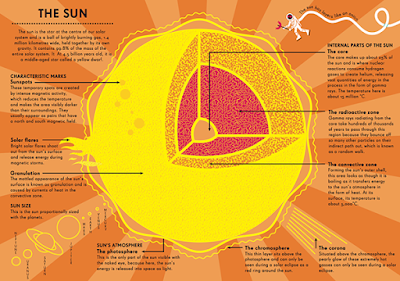By Larisa Epp
Data is all around us, and as designers, this may not seem important. But it is. All graphic designers should pay attention to data, as it can be a useful tool when conducting research for a project or even when designing the project itself. There is a whole field centered on designing data, known as data visualization, which includes infographics. This series of blog posts, Data Designers, will showcase successful graphic designers who design with data at the forefront of their minds.
“I surround myself with people who are much smarter than I am. Then I latch onto them and try to pull out what is interesting to them and what is interesting to me. Wherever it overlaps, that's what makes it in the graphic.”
Photo Credit:
All images: via Daniel’s Behance portfolio or The Origin of (Almost) Everything.
Data is all around us, and as designers, this may not seem important. But it is. All graphic designers should pay attention to data, as it can be a useful tool when conducting research for a project or even when designing the project itself. There is a whole field centered on designing data, known as data visualization, which includes infographics. This series of blog posts, Data Designers, will showcase successful graphic designers who design with data at the forefront of their minds.
Wrapping up the Data
Designers series, we’ll take a look at Jennifer Daniel, an amazing illustrator.
She combines her illustrative graphics and editorial skills with data and
information to tell stories as well as inform and entertain the viewer. Daniel
has worked as the graphics director at Bloomberg
Businessweek, a visual journalist at the New York Times, and currently the UX manager for emoji at
Google—deciding what Google’s emoji set will look like. Additionally she has
designed for the book, The Origin of (Almost) Everything, as well as for a children’s book SPACE!Infographics.
Daniel has been called a genius when it comes to information
design and infographics. Her designs are fun and provocative, pushing people to
pay attention and then think about the message being conveyed. In fact, when
approaching her designs she says she likes to focus on the provocative because
“provocative makes people think, funny makes people laugh” (Rubino, 2010). Additionally,
Daniel focuses primarily on research
and design in order to create the
best information graphics possible. She says “most of my time is spent
researching and designing diagrams, maps, and charts…because ultimately what
I’m supposed to do is turn [a basic bar graph] into this:" (Leslie, 2013).
Ultimately, she combines this approach with a special
outlook on data and information graphics. While at the New York Times, Daniel and her team developed a practice to
designing infographics called the “Bart
and Lisa approach” (Miller, 2016).
Basically, this involves creating something that “will appeal to someone
with a low-attention span, or a reader who will appreciate the big picture”—or
a Bart Simpson (Miller, 2016). At the same time, this design should also speak
to individuals who like to get into the nitty-gritty details and who want to
“walk away having learned something new”—or a Lisa Simpson (Miller, 2016). This
allows for complex graphics and illustrations to be created with layers of
messages to be understood. You can easily get the main point from briefly
looking at it, but you can also learn more if you wish to. This is a great
perspective that not only information designers or data visualizers should
consider testing out, but all graphic designers.
“I surround myself with people who are much smarter than I am. Then I latch onto them and try to pull out what is interesting to them and what is interesting to me. Wherever it overlaps, that's what makes it in the graphic.”
–Jennifer Daniel (Miller, 2016)
And thus, I leave you with this final point about data and
design: As designers who use data, don’t forget to find the interesting bits of
data—the data that teaches you something new and tells a story. This data will
be key in making your information designs great.
Other Data Designer Series Posts
Sources:
Leslie, J. (Interviewer)
& Daniel, J. (Interviewee). (2013, March 25). At work with… Jennifer
Daniel, Bloomberg Businessweek [Interview transcript]. Retrieved from
Magculture website: https://magculture.com/at-work-with-jennifer-daniel-bloomberg-businessweek/
Miller, M. (2018, December
8). The “Bart and Lisa” theory of
information design. Retrieved from https://www.fastcompany.com/3066148/the-bart-and-lisa-theory-of-information-design.
Rubino, C. (Interviewer)
& Daniel, J. (Interviewee). (2010, November 26). Fresh & hungry: Jennifer Daniel
[Interview transcript]. Retrieved from http://idsgn.org/posts/fresh-and-hungry-jennifer-daniel/.
Photo Credit:
All images: via Daniel’s Behance portfolio or The Origin of (Almost) Everything.






Comments
Post a Comment